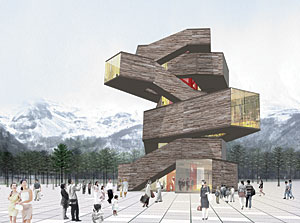For a 43,055-square-foot tourist entertainment center under construction in the famed Changbaishan mountain region in China, architect Xu Tiantian’s was at first less concerned about the buildings than where they sit—a patch of primeval woodland with a gorgeous mountain backdrop. “The beauty there is so overwhelming,” says the principal of Xu’s Beijing-based DnA_Design and Architecture. “So we decided that maybe the most convincing way to design this building was to have a dialog with nature.”

Instead of a single “big block” complex, Xu created a trio of buildings that mimic natural forms, signaling the programs within. As the first of a series of buildings in the new town of Baixi, the project was meant “to create a certain language that could influence the future buildings in that area,” she says.
The three buildings are set in a triangular formation on a site cut through by a creek. An 82-foot-high wood-and-steel viewing tower, called the Info Tree, juts out in all directions like a signpost pointing to various pastoral sights. A bright-red steel core contains stairs and an elevator, bringing visitors to platforms that offer panoramic views of the surrounding mountains and forest.
Nearby will stand an entertainment center, The Rock, whose bulky exposed-concrete and mostly opaque facade echoes the stone of mountain cliffs. In addition to a theater, a ballroom, and karaoke rooms, the building will offer a plaza for public dancing and, on the roof, an amphitheater for outdoor performances.
A third building, named Bridging Water, hovers above the creek and a set of indoor and outdoor pools spreading out along a series of cantilevered walkways. In winter, ice skaters outdoors will be separated from swimmers inside merely by panes of clear glass. With a white floral pattern etched into the glassy surface, the facade will shimmer in the water’s reflection.
The buildings’ distinct styles not only differentiate them from each other but will set the Changbaishan resort apart from resort towns across China. For an area long closed to tourism, local officials wanted to avoid the “fake antique villages” common to tourist spots. “The atmosphere here is not something you can just take from Beijing or [the natural resort] Jiuzhaigou,” says the architect. Instead, her design, she explains, “becomes an identity. We wanted to create something for the place and for the future.”
Although Xu started DnA just four years ago, she has already completed important works such as the Ordos Art Museum in Inner Mongolia and the Xiaopu Cultural Center in Songzhuang, outside of Beijing.





